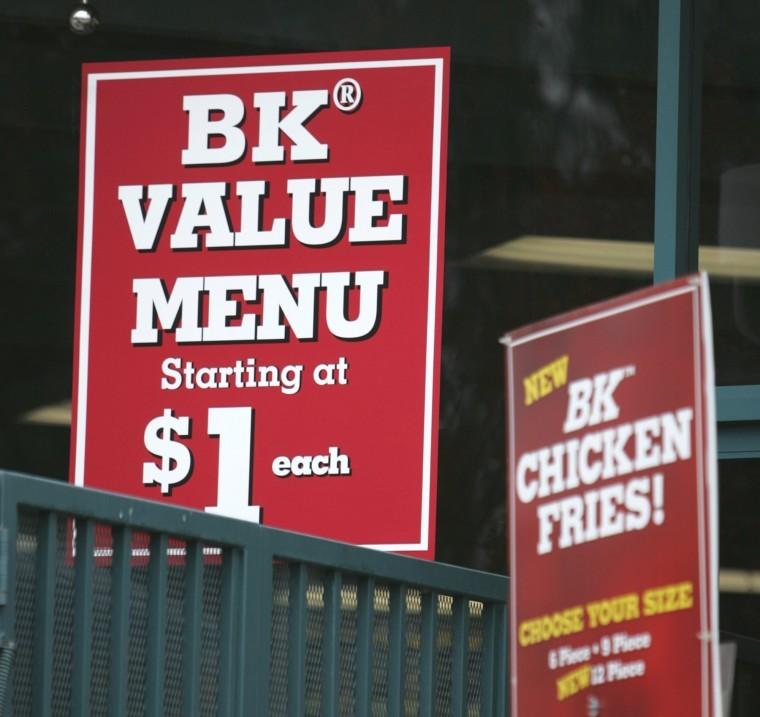Panda Express and Mother India offer healthy choices
Burger King is testing a value menu in some Southern California stores, including this one in Irvine, California. (Michael Kitada/Orange County Register/KRT)
June 1, 2011
It might come as a surprise to some Sacramento State students, but there are actually healthy options when eating on campus. Even when dining at places like Panda Express, where the most popular items on the menu are deep fried and doused in sugar, there is more than one way to go for the weight-wary. The ultimate question, though, is whether students care what they eat, or will they simply stuff whatever is tasty and convenient down their throats?
Panda Express and Burger King, two of the biggest names in fast food, are also two of the most popular spots on campus to grab lunch. Luckily for the health-conscious, federal law requires all restaurant chains with more than 20 stores to make nutritional information available to customers.
Burger King’s Triple Whopper is among the least healthy foods at Sac State. This monster packs 1,140 calories and 75 grams of fat. A sensible alternative for the carnivore on campus is the Tendergrill chicken sandwich. It has less than a quarter of the fat and a little more than one-third of the calories, making it easier on the waistline.
Panda Express, the titan of Chinese cheap eats, also has some dishes that are better than others. Its signature orange chicken, while not quite the least-healthy item on the menu, is close to the bottom of the list. It is fried and coated in a sugary sauce, a combination some find irresistible. An alternative is the string bean chicken breast has less than half the calories and roughly one-third of the fat.
Panda Express is relatively new to campus, having replaced Kung Fu Fat’s, which closed last semester. Senior environmental economics major Laurel Rhodes said she would rather see a healthier outfit in its place.
“I think (University Enterprises, Inc.) really screwed up by letting two Panda Expresses come onto
campus,” she said. “I personally boycott this vendor. I think the students should have had a choice about what vendor replaced Kung Fu Fat’s.”
Although it may come as a shock to some, one of the worst-for-you foods in the University Union comes from Jamba Juice, a name generally associated with healthy snacks and fresh fruit smoothies.
A standard-sized Peanut Butter Moo’d drink, however, contains 700 calories and 20 grams of fat. The chain’s flagship fruit drinks, though, contain almost no fat, making them all great alternatives.
Sheru Singh owns Mother India, Sac State’s sole purveyor of cuisine from the subcontinent. He said his restaurant has many healthy options, although as of now he does not offer nutritional information.
In years past, UEI employed a nutritionist who kept track of these statistics. When she left for another job, the position was never filled.
Singh, who has sold food on campus for almost a decade, said his healthiest dish is the tandoori chicken. In keeping with Indian tradition, the chicken is skinless and cooked in a tandoor oven, similar to a barbecue. Singh said this process essentially burns off most of the excess fat from the meat.
He also said since he has many customers who try to stick to a vegan lifestyle, he no longer marinates the chicken in a yogurt-based sauce or garnishes his chickpea dish with butter, reducing the fat content further.
Miguel Ayala, who owns Gordito Burrito, also said his effort to cater to vegetarians makes his dishes healthier. His rice and refried beans, two items that oftentimes contain some animals products, are made vegetarian. This makes them lower in fat.
Singh said the real barrier standing between Sac State students and healthy eating, though, is not the lack of choices. It is that most of them just do not care. He said the current generation of college students was brought up on school lunches of pizza and fried food, so it should not come as a shock when they want to eat similar food now.
If students did care, he said, the least healthy restaurants would not be the busiest.
“That is the dilemma that we all as business people face,” Singh said. “We can gear our food toward healthy options, but people really do not pick them. We cannot flip our menu into nothing but healthy options, because no one is going to eat it.”
No matter where one goes on campus, there are plenty of healthy choices. The more students pick these foods, the more options there will be that not only fill them up, but also help them stay in fighting shape.





























































































































